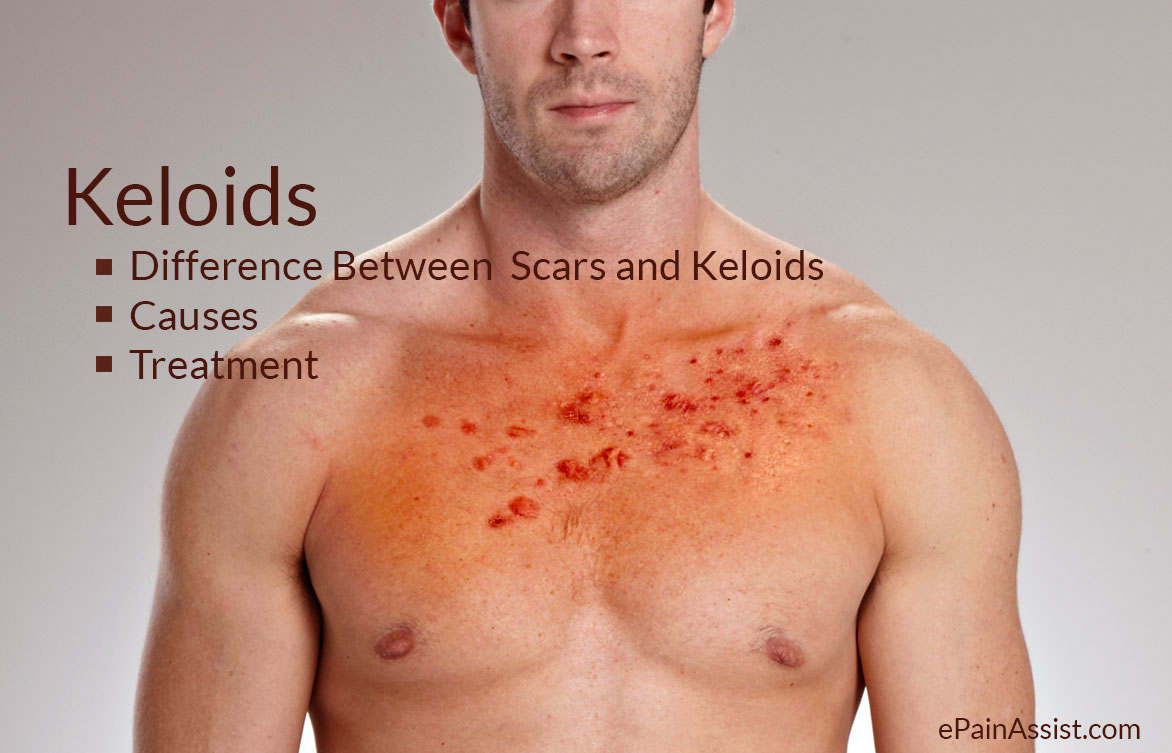Keloid is a scar which continues to grow and build up unlike a normal scar. Keloid is also elevated from the surrounding skin. Keloid is purple or pink in color, is somewhat hard in texture with a smooth top. They are irregularly shaped and have a tendency to grow in size quite progressively. The major difference between a normal scar and a keloid or a keloid scar is that normal scars fade away over the time and keloids do not. Keloids commonly develop on the ches, shoulders, back and earlobes. They can also develop on the jaw line and rarely on the face.
Treatment comprises of steroid injections, laser therapy, radiation, Interferon injections, Fluorouracil injections, and cryotherapy.
Causes of Keloids
The exact cause of why keloids form in some people/situations and do not form in others is not quite clear. According to expert, changes in the signals of the cells which are responsible for proliferation and growth control can be responsible for formation of a keloid. However, nothing has been proved conclusively. Keloids can form after minor injuries, such as piercing of the body. However, piercing does not always lead to keloids formation. Keloids also tend to be hereditary.
Difference Between Scars and Keloids
After any injury to the skin, it heals by usually leaving behind a flat scar. In some patients, the scar can be thickened or hypertrophic; however, it is confined to the wound margins. Scars which are hypertrophic are redder and tend to fade on their own over a period of a year or more. Cortisone injections help in speeding the healing process.
Keloids, on the other hand, start to develop sometime after the injury has occurred and go beyond the site of the wound or extend beyond the wound margins. This tendency of migrating into the surrounding areas other than the actual wound site is what differentiates keloids from the hypertrophic scars. Keloids commonly develop after any injury or surgery, but they may also develop after any mild inflammation, such as pimples etc. and minor injuries, such as piercings, burns etc.
Signs and Symptoms of Keloids
- Keloids are shiny and dome-shaped in appearance.
- They are like enlarged scars and are raised above the skin.
- They can be of pink, purple or red in color.
- Sometimes, the keloids can become very large in size and can be quite embarrassing for the patient.
- They can be itchy and tender to touch.
- Patient may also experience pain upon touch.
Risk Factors for Keloids
- Keloids are more common in adults when compared to children and elderly.
- Women tend to be at a slightly higher risk for keloid formation due to piercing of earlobes etc.
- Individuals with darker skin are at a higher risk for developing keloids.
- Keloids can also be hereditary, so having a family history of keloids increases the risk.
Treatment for Keloids
Treatment for keloids is important, especially if they are painful, itchy or are if they are causing disfigurement and are a source of embarrassment for the patient. The larger the keloid, the more difficult it is to treat it. Treatment of keloids consists of:
- Cortisone injections given into the lesions are quite safe and are beneficial. The injections are given once in a month until the keloids have flattened as much as possible. The side effect of cortisone injections is that the keloids may look redder in appearance due to formation of superficial blood vessels. However, even after successful treatment, there is a scar left behind which looks different than the surrounding skin.
- Surgery can be done, but is quite risky, as cutting the keloid can trigger formation of larger or same sized keloids. Application of pressure and injecting steroids to the wound site after excising the keloid can be beneficial. Radiation therapy after the surgical excision can also be done.
- Laser treatment or pulsed-dye laser is quite effective in flattening the keloids and reducing their redness. This is a safe treatment; however, patient may need many sessions of this treatment to achieve complete results. Laser treatments are costly as most of the times these are not covered by the insurance.
- Silicone gel sheets applied over the affected region for many hours and for many weeks to months can give variable results.
- Cryotherapy, which is freezing keloids using liquid nitrogen, helps in flattening the keloids, but darkens the area of treatment.
- Interferon injections have shown to decrease the size of the keloids. However, whether this has a lasting effect of not is not proven, as research is still being carried out.
- Fluorouracil Injections, which is a chemotherapy drug, can be given alone or in combination with steroids for treating keloids.
- Radiation is also helpful in treating keloids.
Prevention of Keloids
Prevention is the best treatment. If a person is prone to keloid formation, then they should avoid cosmetic or elective procedures/surgeries to the skin, such as piercing.
Also Read:

